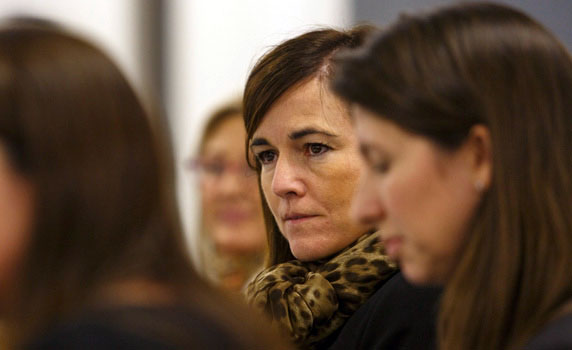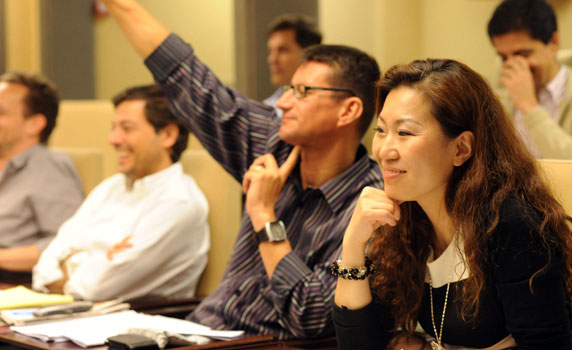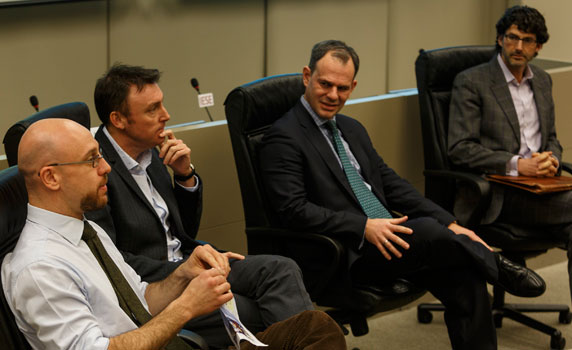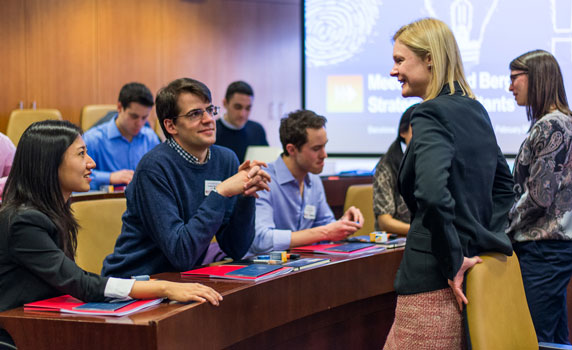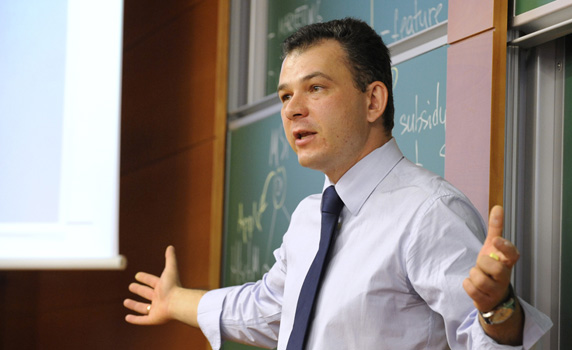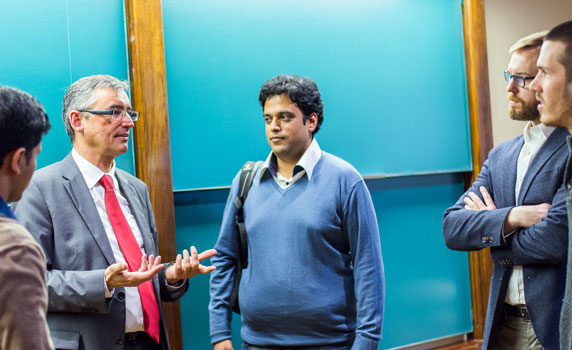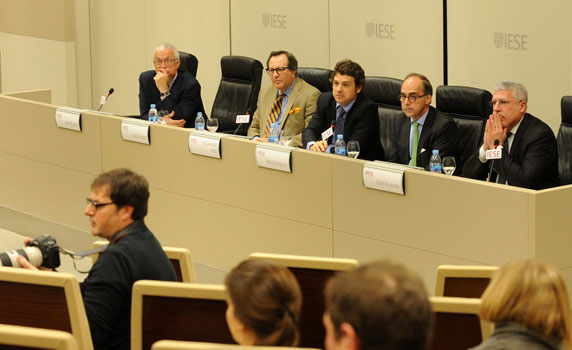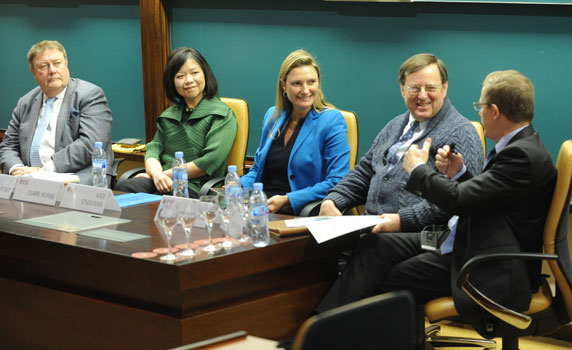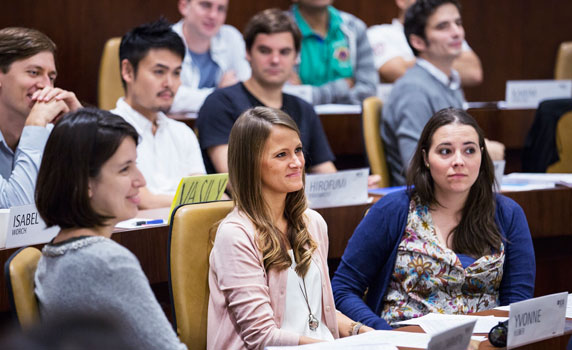![]()
Two big concepts are set to shake up the media industry over the next few years. "Net neutrality" and "over the top" consumption of content will be dominant forces affecting the sector, according to members of the IESE U.S. Council who shared thoughts with MBA students on campus in Barcelona last week.
President Emeritus of Educational Broadcasting Corporation, Bill Baker, Christopher Vollmer, partner at Strategy&, Alan Glazen formerly of Glazen Creative and Carmen Di Rienzo, founding president and CEO of V-Me Network shared insight and took questions from more than 100 students.
In particular, they focused on video content – where is it coming from, how is it consumed and how can it create value tomorrow?
Over the Top
We’re seeing increasing "over the top" consumption of media, thanks to video services from Netflix, YouTube, Hulu, Amazon and others. The new media players are referred to as over the top (OTT) because they use broadband Internet to bypass the traditional media channels. They don’t have to pay for licenses to reach global audiences; they just send their content on top of the Internet infrastructure in place.
OTT is disrupting the traditional media business models profoundly, the panelists explained. Licenses are no longer needed, competition is no longer limited, and audiences are no longer gathered around television sets. Bill Baker explained that "cord cutters" are an increasing reality, as people consume video via the Internet, often on mobile devices, cancelling their $100-per-month subscriptions to cable TV. V-Me’s Carmen Di Rienzo pointed out that we are even seeing "cord nevers" enter the picture -- young people who have never relied on traditional media.
Baker cautioned that, thanks to these disruptions, what happened to the music industry could happen in media. "Selling entire albums would bring in money, even if people only wanted one song. With digital, the music industry has been destroyed. And the video world with the cord cut could end up like that. We don’t want that," Baker emphasized.
But with OTT disruption also comes opportunity. "There’s the potential for an enormous audience, a global audience," noted Di Rienzo. "And after that, there’s the long tail, with smaller players. I see innovation happening in the long tail," she said.
New Net Neutrality Rules to Combat "Two Speed Internet"
Just two services – Netflix and YouTube – now account for half of all U.S. Internet traffic. Online video offerings are challenging and changing the nature of the Internet today. Big telecom and cable providers, such as AT&T, Verizon and Comcast, have been in favor of charging the largest bandwidth users more for a "fast lane" on the Internet to help them recoup their sizeable investments in expanding broadband capacity.
Opposition to this has been significant. Critics argue that it creates a "two-speed Internet," with smaller players and entrepreneurs left in the "slow lane."
The United States recently ruled in favor of "net neutrality," a measure that aims to bind Internet service providers to the concept of a free and open Internet for all users.
"The Internet should be regulated like a utility. This is what the Federal Communications Commission [FCC, which regulates communications in the U.S.] is saying," explained Bill Baker, President Emeritus of Educational Broadcasting Corporation. "This is new and it is not clear how it is going to work."
Content Is King But Who Will Pay For It?
Christopher Vollmer, who is Global Managing Director at PwC network’s Strategy &, offered three key insights on business models that have the best potential to survive.
First, "with video on devices [besides the TV] you have to care more about the user experience. This means there’s a need for new skills in the media industry," he said.
Second, analytics have grown especially important, especially to advertising-supported media. Increasingly sophisticated measurements should be being used to deliver ad-supported video content to individual profiles, demographics, consumption preferences and more, Vollmer explained.
Vollmer noted that advertising-supported video is currently a $70-billion business and that its subscription model – Pay-per-view and Netflix among others -- brings another $50-70 billion in value.
Third, Vollmer sees the most growth for the next three to five years, not in ad-based but in subscription-based video offerings. Netflix stands out in this area now, and one of Netflix’s secrets to success is its original content.
With 35 to 40 million subscribers in US and another 10-plus million in Europe and the rest of the world, Netflix is investing heavily on original series and exclusive content to keep growing its subscription base. Competitors are following suit. "I predict there will be a shakeout soon."
Vollmer also described what he sees as a land grab for the elusive youth audience. Companies are trying new things. "Disney bought Maker Studios, which sits outside the traditional video ecosystem," he said. With tens of thousands of producers making short-form videos, Maker generates 11 billion views each month, Vollmer noted. Elsewhere, a new platform, SnapChat, popular with an under-25 audience, launched SnapChat Discover to "tell stories."
New Opportunities on All Levels
Alan Glazen, whose career spans advertising, video production and entrepreneurship, gave a sardonic take on this evolving environment. Wherever there is a vacuum, he said, "criminal elements" are there to fill it.
Organized crime is an estimated $600 billion business, Glazen told MBAs and called on them to put their education to work to find better ways to use the Internet as a media platform.
Di Rienzo reminded the audience of the "very global nature" of media today. The old rules about sharing a piece of the media pie have gone, she said: "Today we have the potential to have big, even enormous audience. Really, it’s an unlimited pie."
As the market grows, new players are entering the arena, and there are new opportunities on all levels. "This business is so exciting – and that’s not going to change."
![]()


